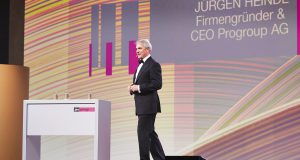It took a phoenix to let an eagle soar again.
GRAEME RODDEN
Greek mythology describes the phoenix as the bird that is cyclically regenerated or reborn; typically the phoenix rises from the ashes. In this story, the phoenix is an eagle—American Eagle Paper Mills, Tyrone, PA. It began Project Phoenix in 2013 to “reinvent the mill’s critical infrastructures by primarily focusing on efficiency.”
 Energy—water, steam, electricity—was the main target. The mill was built in 1880 and is one of the oldest operating paper mills in the US. Management realized improvement had to be made to ensure the mill’s future; the project also provided immense environmental benefits.
Energy—water, steam, electricity—was the main target. The mill was built in 1880 and is one of the oldest operating paper mills in the US. Management realized improvement had to be made to ensure the mill’s future; the project also provided immense environmental benefits.
The mill now produces 85,000 tpy of uncoated printing and writing grades using a 100 percent recycled furnish. There are two 1940s-vintage paper machines (Pusey & Jones), which have gone through numerous upgrades over the years. “There’s not much original stuff left,” notes American Eagle CEO Mike Grimm.
Its main market segment is recycled copy paper. American Eagle can take advantage of many government (local, state, federal) regulations that mandate the use of recycled content in the paper that “tax-supported offices” buy. “We’ve grown rapidly in this segment recently,” Grimm says. The mill also produces general offset, envelope, and some colored paper grades, as well as private label paper.
Project Phoenix addressed multiple issues facing the mill. Grimm lists the three biggest risks:
• Power boiler;
• Steam turbine generator;
• Proprietary frequency converter.
The mill’s frequency converter was the only one of its type in the world. As Grimm points out, “If it had failed, it would have been catastrophic for continuity.”
There were also issues with the insurer, which wanted changes to the electrical system.
 A consultant had done an EPC study earlier, but came in with a price tag of US$15-16 million. Management decided to design the project in-house, although a general contractor was hired. “We had a great team with great buy-in at all levels of the organization,” Grimm says.
A consultant had done an EPC study earlier, but came in with a price tag of US$15-16 million. Management decided to design the project in-house, although a general contractor was hired. “We had a great team with great buy-in at all levels of the organization,” Grimm says.
The process began in 2013 with a lot of evaluation. The mill was spending about US$12 million annually on steam, power generation and purchased power. As the team went through the mill, it started to discover it had opened a “can of worms” because of the equipment inefficiency (too big, too old). Basically, the three main pieces—boiler, steam turbine generator, old static frequency converter—were due to fail and if any one of the three did, the mill would need to be shut.
“We also realized how much steam we need to run the paper machines and this put us in the direction of a package boiler,” Grimm adds.
The project team studied multiple alternatives and made technical decisions by early 2015. To get through the capitalization of the project, ownership had to be restructured. In June/July 2015, orders for the larger equipment were placed.
Construction started in February 2016. Luckily, an existing building was able to house the new package boiler. The new Babcock & Wilcox natural gas-fired package boiler looks like it was made for the space, Grimm says. The new boiler and frequency converter were turned on in mid-July 2016. Total cost was US$8 million. It should be noted that the project was all debt or equity financed; there were no grants received.
RIGHT-SIZING POWER
Spread over 30 acres and once housing five paper machines, the mill was oversized for what it had become. For example, the power infrastructure was expanded in 1957 with the installation of a Babcock & Wilcox coke boiler that could generate 250,000 lb/hr of steam. It fed a 6-MW Westinghouse generator.
“We were sized for a much larger operation. It was too big a system for a small mill,” Grimm adds. “When we did the study we realized we were oversized, so the economic factor alone was a spur. Then the environmental factor was a whole other story.”
 The new boiler can generate 125,000 lb/hr of 200 psi steam. It is running at about 70 percent capacity at present, which is the way it was designed for the mill. One of the main aims was to match steam capacity with steam needs.
The new boiler can generate 125,000 lb/hr of 200 psi steam. It is running at about 70 percent capacity at present, which is the way it was designed for the mill. One of the main aims was to match steam capacity with steam needs.
American Eagle worked with the local utility to shut the mill’s power generating capacity and instead buy power from the grid. Before the US adopted 60 Hz as a national standard frequency for the electrical grid, some power utilities operated on a frequency of their own choice (in Pennsylvania, 25 Hz was quite common). This means companies established before this nationwide standard had electrical equipment that operated on a different frequency and were incompatible with the power grid. This was the case for American Eagle—it was built in 1880, long before the national standard was set. With its equipment operating on a 25 Hz frequency, the facility was incompatible with the 60 Hz distribution grid.
To solve this problem, the paper mill used a steam turbine that powered the facility at a 25 Hz frequency and allowed the equipment to run. While using the generator was more economically viable than upgrading all of the motors and machinery, maintaining and operating the steam generator to produce electrical power was becoming cost prohibitive.
To help reduce operating costs and maintenance, ABB was asked to supply American Eagle with a static frequency converter (SFC) to source power from the 60 Hz grid and convert it to 25 Hz. This would enable the generator to more efficiently power the facility and equipment. ABB delivered two SFC units, each rated at 2 MVA, housed in 40-ft NEMA-rated containers. Each container included all the ancillary equipment required to connect the SFC units to the grid and deliver power to the facility. The protection cabinet, input and output transformers, power electronics, and control cabinet were integrated into compact containers, offering simple installation and a plug-and-play approach.
The new ABB frequency converters and load center power-factor capacitors were designed and installed to condition 100 percent of the electrical load of the mill. In all, this saves about 2.7 million kWh/yr. Before the new system came into place, the mill had four Westinghouse turbine generators, one dating back to 1917.
The mill is located in a strong power-generating region: hydro, natural gas (fracking), and coal are all available, so American Eagle was able to negotiate an “attractive” long-term (five+ years) power supply agreement. It now purchases about 8 MW. “For us, buying power and installing the package boiler for steam generation made a lot of sense,” Grimm says. Payback is estimated at less than three years.
Environmentally, greenhouse gas emissions have dropped by 68.7 percent, to 103,815 tpy (combined savings for overall emissions footprint: electrical and steam). Purchased energy efficiency (MMBtu improvement per ton of paper) has improved 33.7 percent to 14.6 MMBtu.
The old frequency converter was installed in the 1990s and it could convert 25 HZ to 60 Hz. However, the mill was still limited. It wanted to drop all 25-Hz power, but delayed the decision. Now, if it wants to shed more 25-Hz power, it has the ability.
The equipment was all manufactured off-site, brought in, installed, and tied in to the mill’s BUS. ABB did all the prior commissioning. “It was relatively simple,” Grimm says.
According to the mill, additional electricity savings were achieved by eliminating parasitic electrical load from the shutdown of the existing power infrastructure. As a result, the mill-wide power-factor improvement is 15.2 percent. It went from .8556 to .9862 after startup of the new system. There has been a 6.6 percent reduction in electrical use, from 74.2 million annual normalized kWh to 69.3 million.
SAVING WATER
As impressive as the energy saving measures have been, the reduction in water consumption has been outstanding. Although there were a few lesser projects that American Eagle was doing to reduce water use, shutting down the turbine as part of Project Phoenix had the largest effect. “We did not realize it at first, but after we got into it, we realized how significant it would be. The amount of water that runs through the system is much less,” Grimm says. “The fact that we no longer need non-contact cooling water accounts for 90 percent of the drop.”
The total reduction in daily water consumption has been 1.5 million gallons, a savings of 91 percent. Process water effluent per ton of paper has been reduced by about 2,000 gallons, an 18.1 percent saving.
The mill installed 5,000 ft of new piping, improving the efficiency of the steam distribution and collection of condensate to reduce waste. A custom water treatment system, scaled to match the new boiler, treats condensate more efficiently and helps to further reduce water waste.
The mill makes up 100 gal/min of fresh water. The old treatment system was close to the old boiler. From an efficiency standpoint, it made more sense for the system to go into the new boiler building. Although space was tight, the mill made it work.
Fresh water first passes through a clarifier that American Eagle bought used. There are three new multi-media filters, three new ion exchange softeners, and a new deaerator. The new condensate return system was tied into the existing repurposed condensate polisher.
“Water use reduction is one of the key American Forest & Paper Association (AF&PA) metrics,” Grimm explains. (Grimm is a member of the board of directors of the AF&PA.) “Regulation is an issue that could be on the horizon.” And though the mill is located in a region with abundant fresh water resources, Grimm believes the mill is doing the right thing. Overall, its sustainability footprint is impressive for a small mill, says Grimm, “and that’s what we are trying to accomplish.”
Although covering 30 acres, the east side of the site is now idled. This included the steam generation equipment and coal boiler. “We’re now a lot simpler,” Grimm adds. “We put the new boiler right next to the steam distribution line. We did not need to run a lot of pipe. We also saved a lot of money by not having to break ground for a new boiler house.”
A year after completion, Project Phoenix has taken flight. The mill faced only “limited” issues after startup. The frequency convertor has operated “solidly,” as has the new boiler.
Grimm notes that the work “exposed” some things that had to be improved in the process, such as condensate return.
Training needs were minimal. Operators learned the new controls and equipment rapidly. “It was a lot less painful than I thought,” Grimm adds. During the annual maintenance shutdown, the old system was stopped and the mill restarted with the new system in six days.
restarted with the new system in six days.
Project Phoenix is not a one-off for American Eagle. The company has invested about US$15 million since 2013. For example, a new warehouse was built in 2015.
In 2012, a new bleaching/dispersion system was added, allowing the mill to produce high-bright paper: 92 point. Previously, 84 point was as high as it could go.
Now that Project Phoenix is behind them, Grimm says the mill wants to catch its breath. “Let’s run for a few years.”
In the future, the mill is looking at adding more cut sheet capacity for value-added reasons. It currently produces about 50 percent rolls and 50 percent sheets. It would also like to convert the drives and motors of PM 3 from 25- to 60-Hz.
“We are in a small niche,” Grimm explains. “We are the low-cost recycled manufacturer in the US. We manufacture more 100 percent recycled paper than anyone else.”
This is the niche in which American Eagle will continue to focus its product development: virgin products that today have no recycled equivalent. “The flexible recycled mills will be successful in the future,” Grimm concludes.
Graeme Rodden is senior editor, North and South America, Paper360°. He can be reached at grodden@tappi.org.
A Bit of Background
The Tyrone mill was built in 1880 by two local partners to take advantage of abundant wood and water resources. They also built the nearby Roaring Spring mill (now owned by Appleton). The company was later sold to the West Virginia Pulp & Paper Company, which became known as Westvaco. The Tyrone mill went through a series of expansions and at one time there were five paper machines operating.
The mill started its recovered fiber operations in the 1990s, using about 1,600 tons/month. Now down to the two machines, one produces coated paper using 50 percent secondary fiber. The uncoated machine used a 100 percent secondary fiber furnish.
In 2001, after Westvaco merged with Mead, the mill was shut. It remained idle until 2003 when Team Ten LLC purchased the Tyrone assets and set to work restarting the mill. The Ten refers to the number of people in the ownership group, many of them former and/or present employees, including Mike Grimm.
The mill employs 240 people, many with more than 10 years’ experience. About 25 percent of the workforce returned after the mill restarted in 2003. Finally, the mill’s address may also be familiar to many: 1600 Pennsylvania Avenue. In Washington, DC, it is, of course, the address of the White House, residence of the president.
American Eagle CEO Mike Grimm.
American Eagle is one of the oldest operating paper mills in the US; the original buildings date back to 1880.
The mill found space for the new Babcock & Wilcox natural gas-fired package boiler in an existing building.
The mill installed new ABB frequency converters and load center power-factor capacitors.
American Eagle produces 85,000 tpy of uncoated printing and writing grades using a 100 percent recycled furnish.
Constant Vigilance
Needed for Deinking
American Eagle processes about 8,000 tons/month of secondary fiber of numerous origins: SBS, poly SBS white ledger, and coated book. This includes some poly cup stock that no one else uses to make P&W grades. Producing P&W grades from a recycled furnish can be a complicated process. The system is very “sensitive” to upsets.
American Eagle has one direct entry recycling line for clean recovered paper. There is not a lot of time between the pulper and paper machines. The other stock passes through a cleaning and screening system.
Excellent process control is a must. Constant vigilance for quality is a necessity. Grimm notes that the direct entry is “pretty clean,” but that the deinked fiber needs special attention. This is why American Eagle is looking at improving the deinking system to improve efficiency as a future project.
One benefit of the system is that the mill sells three truckloads per month of plastic waste that it recovers from the system.
 Paper 360
Paper 360


